This pub was built as the Crompton & Evans Union Bank, later the city branch of the NatWest which closed in 1993 and is now, appropriately, called The Standing Order.
An illustration and text about Samuel Taylor Coleridge.
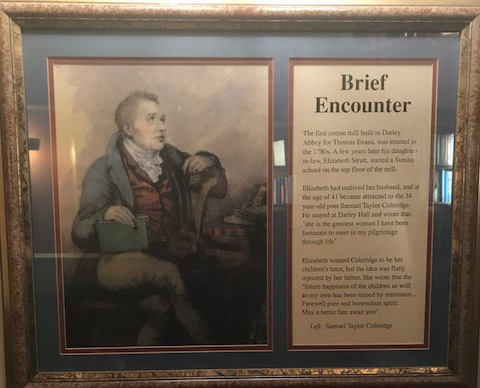
The text reads: The first cotton mill built in Darley Abbey for Thomas Evans, was erected in the 1780s. A few years later his daughter in-law, Elizabeth Sarrat, started a Sunday school on the top floor of the mill.
Elizabeth had outlived her husband, and at the age of 41 became attracted to the 34 year old Samuel Taylor Coleridge. He stayed at Darley Hall and wrote that, “she is the greatest woman I have been fortunate to meet in my pilgrimage through life”.
Elizabeth wanted Coleridge to her children’s tutor, but this idea was flatly rejected by her father. She wrote that the “future happiness of the children as well as my own has been ruined by resistance … Farewell pure and benevolent spirit. May a better fate await you”.
Left: Samuel Taylor Coleridge.
An illustration and text about Derby Cathedral.
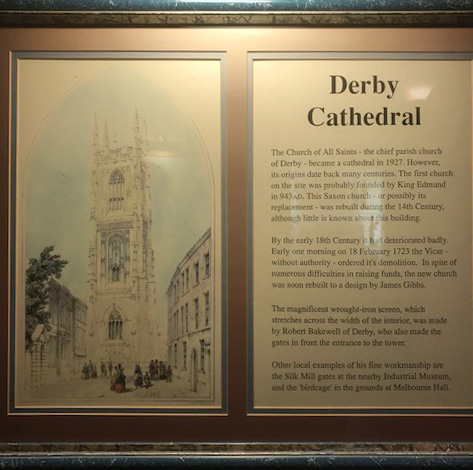
The text reads: The Church of All Saints – the chief parish church of Derby – became a cathedral in 1927. However, its origins date back many centuries. The first church on the site was probably founded by King Edmund on 943AD. This Saxon church – or possibly its replacement – was rebuilt during the 14th century, although little is known about this building.
By the early 18th century it had deteriorated badly. Early one morning on 18 February 1723 the vicar – without authority – ordered its demolition. In spite of numerous difficulties in raising funds, the new church was soon rebuilt to a design by James Gibbs.
The magnificent wrought-iron screen, which stretches across the width of the interior, was made by Robert Bakewell of Derby, who also made the gates in front entrance to the tower.
Other local examples of his fine workmanships are the Silk Mill gates at the nearby Industrial Museum, and the ‘birdcage’ in the grounds at Melbourne Hall.
A print and text about George Fox.
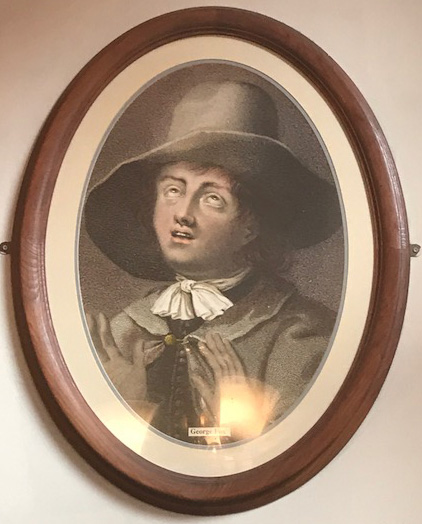
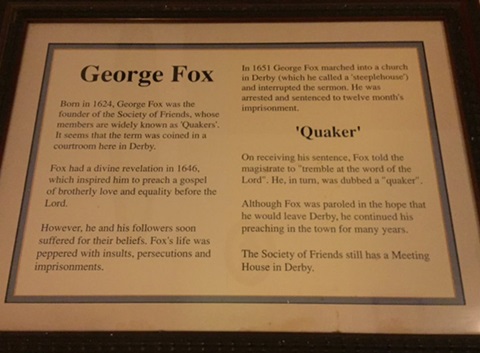
The text reads: Born in 1624, George Fox was the founder of the Society of Friends, whose members are widely known as Quakers. It seems that the term was coined in a courtroom here in Derby.
Fox had a divine revelation in 1646 which inspired him to preach a gospel of brotherly love and equality before the Lord.
However, he and his followers soon suffered for their beliefs, Fox’s life was peppered with insults, persecutions and imprisonments.
In 1651 George Fox marched into a church in Derby (which he called a ‘steeplehouse’) and interrupted the sermon. He was arrested and sentenced to twelve month’s imprisonment.
On receiving his sentence, Fox told the magistrate to “tremble at word of the Lords”. He, in turn, was dubbed a ‘quaker’.
Although Fox was paroled in the hope that he would leave Derby, he continued his preaching in the town for many years.
The Society of Friends still has a Meeting House in Derby.
A print and text about Joseph Wright.
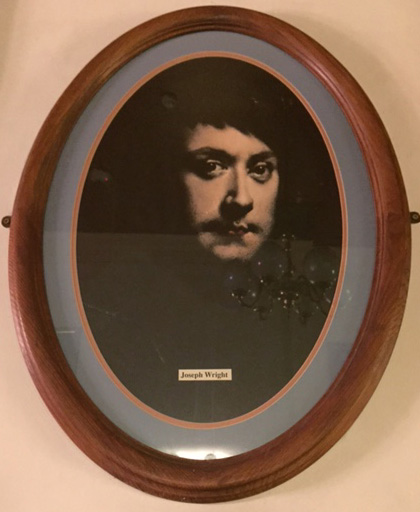
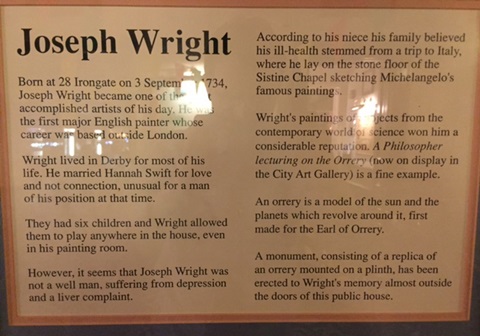
The text reads: Born at 28 Irongate on 3 September 1734, Joseph Wright was one of the most accomplished artists of his day. He was the first major English painter whose career was based outside London.
Wright lived in Derby for most of his life. He married Hannah Swift for love not connection, unusual for a man of his position at that time.
They had six children and Wright allowed them to play anywhere in the house, even in his painting room.
However it seems Joseph Wright was not a well man, suffering from depression and a liver complaint.
According to his niece his family believed his ill-health stemmed from a trip to Italy, where he lay on the stone floor of the Sistine Chapel sketching Michelangelo’s famous paintings.
Wright’s paintings of objects from the contemporary world of science won him a considerable reputation. A Philosopher Lecturing on the Orrery (now on display in the City Art Gallery) is a fine example.
An orrery is a model of the sun and the planets which revolve around it, first made for the Earl of Orrery.
A monument, consisting of a replica of orrery mounted on a plinth, has been erected to Wrights memory almost outside the doors of this public house.
A print and text about John Flamsteed.
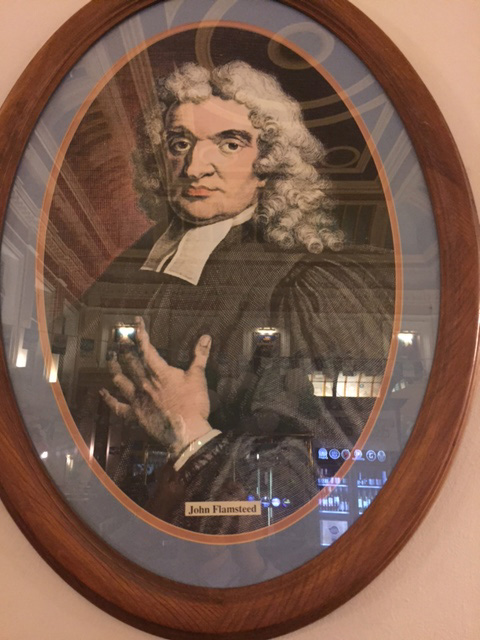
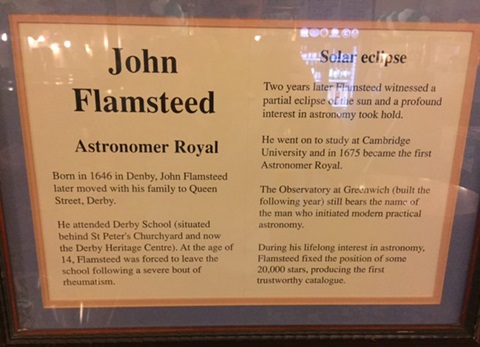
The text reads: Born in 1646 in Derby, John Flamsteed moved with his family to Queen Street, Derby.
He attended Derby School (situated behind St Peter’s Churchyard and now the Derby Heritage Centre). At the age of 4, Flamsteed was forced to leave school following a severe bout of rheumatism.
Two years later Flamsteed witnessed a partial eclipse of the sun and a profound interest in astronomy took hold.
He went on to study at Cambridge University and in 1675 became the first Astronomer Royal.
The Observatory at Greenwich (built the following year) still bears the name of the man who initiated modern practical astronomy.
During his lifelong interest in astronomy Flamsteed fixed the position of some 20,000 stars, producing the first trustworthy catalogue.
Illustrations and text about Derby and ‘The Forty-Five’.
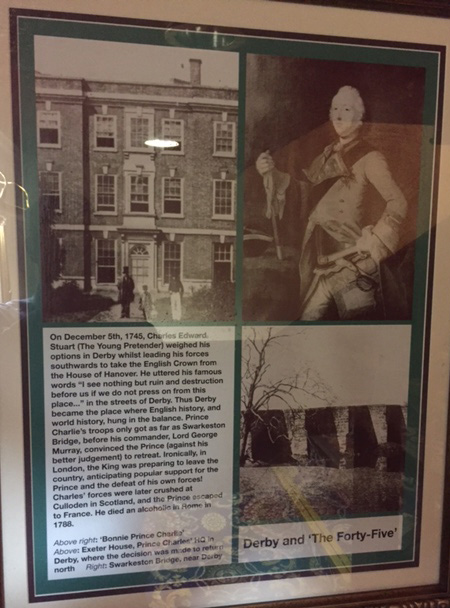
The text reads: On December 5 1745, Charles Edward Stuart (The Young Pretender) weighed his options in Derby whilst leading his forces southwards to take the English Crown from the House of Hanover, he uttered his famous words “I see nothing but ruin and destruction before us if we do not press on from this place…” in the streets of Derby. Thus Derby became the place where English history, and world history, hung in the balance. Prince Charlie’s troops only got as far as Swarkeston Bridge, before his commander, Lord George Murray, convinced the Prince (against his better judgement) to retreat. Ironically, in London, the King was preparing to leave the country, anticipating popular support for the Prince and the defeat of his own forces! Charles’ forces were later crushed at Colloden in Scotland, and the Prince escaped to France. He died an alcoholic at home 1788.
Above right: ‘Bonnie Prince Charlie’
Above: Exeter House, prince Charles’ HQ in Derby, where the decision was made to return north
Right: Swarkeston Bridge, near Derby.
Photographs and text about the silk mill.
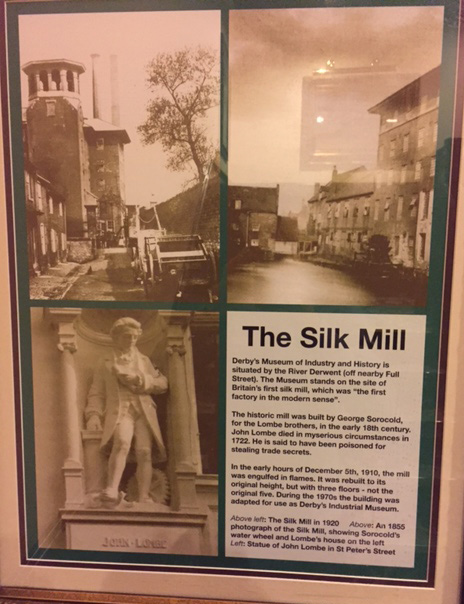
The text reads: Derby’s Museum of Industry and History by the River Derwent (off nearby Full Street). The museum stands on the site of Britain’s first silk mill, which is ‘the first factory in the modern sense’.
The historic mill was built by George Sorocold, for the Lombe brothers, in the early 18th century. John Lombe died in mysterious circumstances in the 1722. He is said to have been poisoned for stealing trade secrets
In the early hours of December 5, 1916, the mill was engulfed in flames. It was rebuilt to its original height, but with three floors – not the original five. During the 1970s the building was adapted for use as Derby’s Industrial Museum.
Above left: The silk mill in 1920
Above: An 1855 photograph of the silk mill, showing Sorocold’s water wheel and Lombe’s house in the left
Left: Statue of John Lombe in St Peter’s Street.
A print, photograph and text about Joseph Pickford.
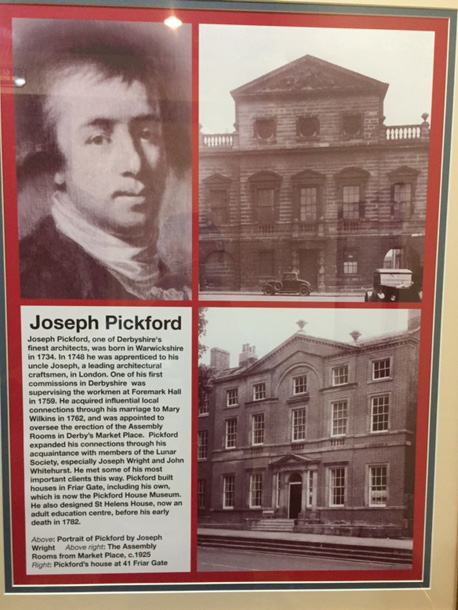
The text reads: Joseph Pickford, one of Derbyshire’s finest architects, was born in Warwickshire in 1734, in 1748 he was apprenticed to his uncle Joseph, a leading architectural craftsmen, in London. One of his first commissions in Derbyshire was supervising the workmen at Foremark Hall in 1759. He acquired influential local connections through his marriage to Mary Wilkins in 1762, and was appointed to oversee the erections of the Assembly Rooms in Derby’s Market Place. Pickford expanded his connections through his acquaintance with members of the Lunar Society, especially Joseph Wright and Joseph Whitehurst. He met some of his most important clients this way. Pickford built houses in Friar Gate, including his own, which is now the Pickford House Museum. He also designed St Helens House, now an adult education centre, before his early death in 1782.
Above: Portrait of Pickford by Joseph Wright
Above right: The Assembly Rooms from Market Place, c1925
Right: Pickford’s house at 41 Friar Gate.
A photograph of the Great Northern Bridge, Friar Gate, Derby, c1910.
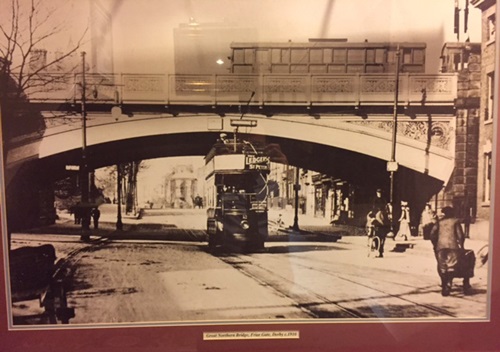
A photograph of the corn market, Derby, c1930.
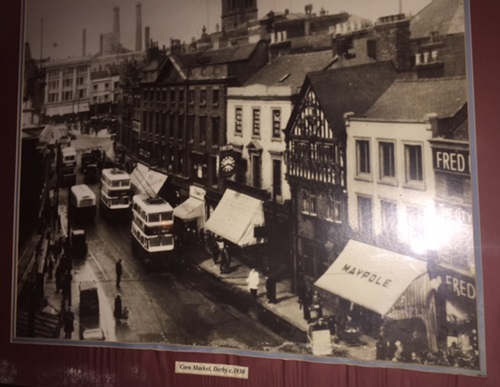
A print of St Peter’s Street, Derby, c1910.
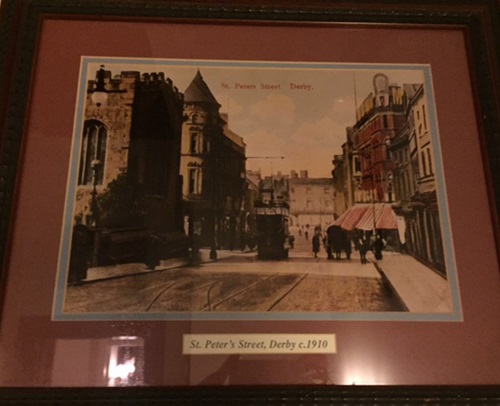
An illustration of the east prospect of Derby.
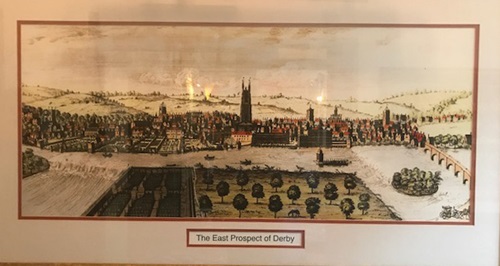
A photograph of Market Place, Derby, c1900.
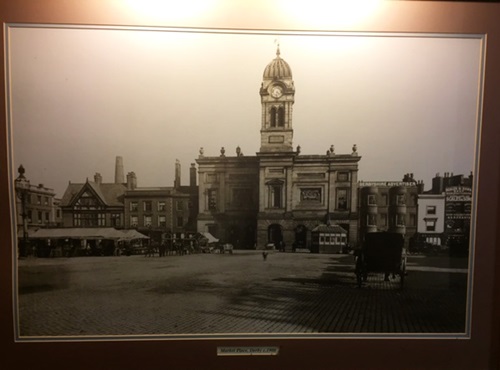
A photograph of Burton Road, Derby, c1910.
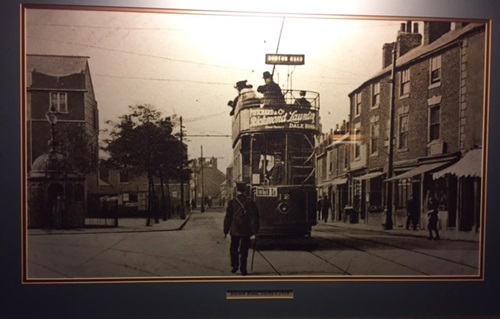
A photograph of the Hippodrome, Derby, c1920.
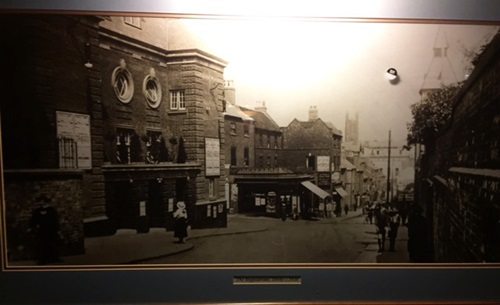
A photograph of the corn market, Derby, c1905.
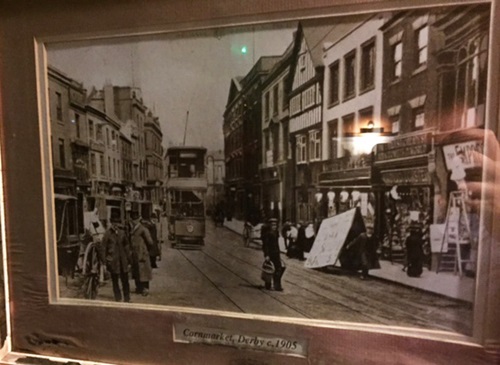
A photograph of Victoria Street, Derby, c1906.
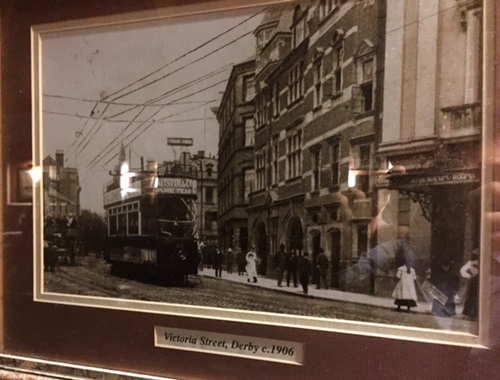
Extract from Wetherspoon News Winter 2018.
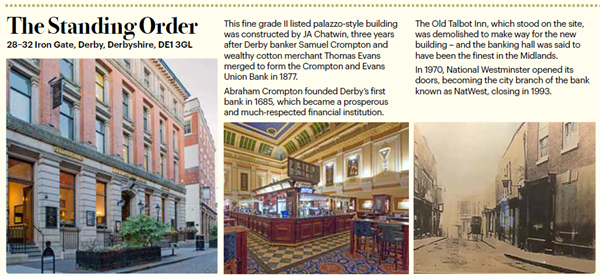
If you have information on the history of this pub, then we’d like you to share it with us. Please e-mail all information to: pubhistories@jdwetherspoon.co.uk